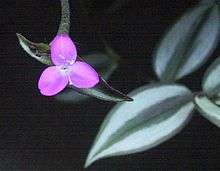Tradescantia zebrina
| inchplant Wandering Jew | |
|---|---|
 | |
| Tradescantia zebrina | |
| Scientific classification | |
| Kingdom: | Plantae |
| (unranked): | Angiosperms |
| (unranked): | Monocots |
| (unranked): | Commelinids |
| Order: | Commelinales |
| Family: | Commelinaceae |
| Genus: | Tradescantia |
| Species: | T. zebrina |
| Binomial name | |
| Tradescantia zebrina (Schinz) D. R. Hunt | |
| Synonyms | |
|
Tradescantia pendula | |
Tradescantia zebrina, formerly known as Zebrina pendula, is a species of spiderwort more commonly known as an inchplant[1] or wandering jew. The common name is shared with closely related varieties T. fluminensis and T. pallida. Tradescantia zebrina is native to Mexico, Central America and Colombia, and naturalized in parts of Asia, Africa, Australia, South America, and various oceanic islands.[2][3][4]
- Varieties[2]
- Tradescantia zebrina var. flocculosa (G.Brückn.) D.R.Hunt - tropical Mexico, Guatemala, Honduras
- Tradescantia zebrina var. mollipila D.R.Hunt - tropical Mexico
- Tradescantia zebrina var. zebrina - most of Mexico from north to south, Central America, Colombia
Description
Tradescantia zebrina has attractive zebra-patterned leaves, the upper surface showing purple new growth and green older growth parallel to the central axis, as well as two broad silver-colored stripes on the outer edges, with the lower leaf surface presenting a deep uniform magenta.
Uses
Cultivation
It is commonly available and used as a houseplant and groundcover. Propagated by cuttings, this plant can be moved or manipulated easily as its runners cling lightly to the ground (if used as cover). It tends to become an invasive species if not properly maintained.
This plant has gained the Royal Horticultural Society's Award of Garden Merit.[5]
Medicinal
It is used in southeast Mexico in the region of Tabasco, as a cold herbal tea, which is named Matali.[6] Skin irritation may result from repeated contact with or prolonged handling of the plant — particularly from the clear, watery sap (a characteristic unique to T. zebrina as compared with the other aforementioned types).
Invasiveness
Classified as a Category 1b Invasive Species in South Africa,[7] and thus in South Africa it may no longer be planted or propagated, and all trade in their seeds, cuttings or other propagative material is prohibited. They may not be transported or be allowed to disperse, both in rural and urban areas.[8][9] It is also an invasive species in Galapagos Islands.[10]
References
- ↑ "Tradescantia zebrina". Natural Resources Conservation Service PLANTS Database. USDA. Retrieved 14 December 2015.
- 1 2 Kew World Checklist of Selected Plant Families
- ↑ Nelson Sutherland, C.H. (2008). Catálogo de las plantes vasculares de Honduras. Espermatofitas: 1-1576. SERNA/Guaymuras, Tegucigalpa, Honduras.
- ↑ CONABIO. 2009. Catálogo taxonómico de especies de México. 1. In Capital Nat. México. CONABIO, México D.F..
- ↑ "RHS Plant Selector - Tradescantia zebrina". Retrieved 5 July 2013.
- ↑ "Wandering Jew / Spiderwort". Project Noah. Retrieved 2016-09-25.
- ↑ http://www.invasives.org.za/legislation/what-does-the-law-say
- ↑ http://www.arc.agric.za/arc-ppri/Pages/Weeds%20Research/Legal-obligations-regarding-invasive-alien-plants-in-South-Africa-.aspx
- ↑ http://www.environment.co.za/documents/legislation/NEMA-National-Environmental-Management-Act-Biodiversity-10-2004-G-26436.pdf
- ↑ http://www.darwinfoundation.org/datazone/media/pdf/64/GR_64_2006_Renteria%26Buddenhagen_Invasive_plants_in_scalesia%20forest.pdf
External links
| Wikimedia Commons has media related to Tradescantia zebrina. |
- Standard Data Report: Tradescantia zebrina - Integrated Taxonomic Information System
- Taxonomy Browser: Tradescantia zebrina - National Center for Biotechnology Information (US National Institutes of Health)
- Desert Tropicals - Informational database on common gardening plants, based out of Phoenix, Arizona, USA
- Tradescantia zebrina - WikiSpecies page